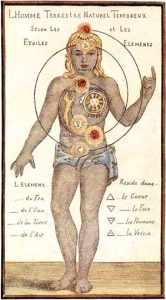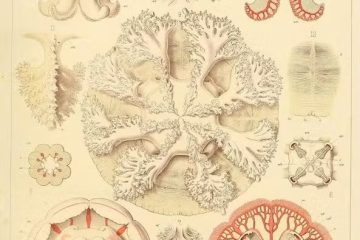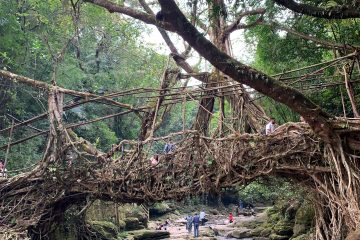Esotericism and Indigenous Knowledge

Reflective natural scientists have known it for a long time: “. . . the existing scientific concepts each fit only a very limited part of reality, and the other part, which is not yet understood, remains infinite” (Werner Heisenberg; German quote from Bewusstseinswissenschaften, page 62). What happens in a society that denies this other part and refuses to deal with it? The other part does not simply disappear; it rather becomes the breeding ground for all kinds of organisms, for wonderful and useful ones, but also for potentially dangerous and harmful ones.
Addressing the “other part” is often linked to what is called “esotericism,” but also to allegedly “primitive,” “pre-scientific” thinking that is found in Indigenous traditions. What both have in common is a different approach to reality than the scientific one prominent today, which operates through distanced observation and through subject-object relations that tend to reify and stabilize the very binary constructions it thrives on. Complicating this trope, we may ask if much of what is attributed to esotericism in fact stems from a past layer of European culture that has lived on in a subliminal way. Even if we don’t call this layer “Indigenous,” it is worthwhile to combine the research field of esotericism with those engaging with Indigenous thinking.
A major hurdle for Western thinking is the linear historical construction of a narrative of progress, according to which everything old is overcome and replaced by the new. What about the knowledge that nonhuman animals, and even plants, are subjects, that they are animate beings with decision-making capabilities and distinct personalities? Indigenous traditions have been claiming this for millennia. Western science has long been blind to it, and all those who today advocate, for instance, a “modern animism” (such as Rupert Sheldrake 1990 and 2020) are accused of projections or esoteric folly. The linear understanding of history should be replaced by the model of a spiral: we come back again and again to old questions, to old knowledges, but we do so at a more complex level, enriched by the experiences made in the meantime.
For a long time, scientists thought in subject-object relationships—in the separation of observer and observed—until quantum physics taught them better. But Western science could also have taken this insight from Indigenous communities and their understanding of subject-subject relationships (as Eduardo Viveiros de Castro explains): the counterpart is empathically perceived as a subject, at eye level, in the shared space of the living cosmos.
A classic of esotericism, Hermes Trismegistus, a legendary author of late antiquity, described the connection and the interconnectedness of the human (microcosm) and world (macrocosm) with the well-known slogan: “What is below is like what is above.” This corresponds to the wisdom of Indigenous cultures. Malidoma Somé, an African shaman, makes this explicit: “The concept of ‘as above so below’ is also found in the tradition of the West. The only problem is that the imbalance does not receive enough attention in the West.” (p. 330). What Somé means is the imbalance between human and cosmos, between the material world and the spirit world, a distinction in Indigenous traditions that does not match European philosophical distinctions of matter and mind.
How can we responsibly incorporate the other part of reality, which Heisenberg talks about, into Western culture?
For sure, Heisenberg offers good reasons for representatives of science to exercise some humility. To simply deny everything that cannot currently be explained scientifically is the worst option. Shamanic healings work, and non-material connections and influences do exist—all these phenomena suggest a different approach to reality than materialistic science favors today. When Western science presents itself as the only possible way of interpretation, critics from other traditions describe that as Western arrogance and ignorance, ultimately as a kind of colonialism that does not take the thinking of non-European traditions seriously.
In the process of intercultural entanglement and learning, can we determine ways to distinguish the medicinal plants from the potentially harmful ones?
In my view, a good way to do so is to apply a practice that is common in science itself: intersubjective authentication. In science, the procedure is clear: measurements have been agreed upon (the meter, hours and minutes, grams, etc.), experiments must be repeatable, and their results must be comprehensible by others.
Indigenous cultures also contain procedures for intersubjective authentication—for example in the shamanic initiation when the Elders distinguish an authentic experience from something that is made up. Western cultures do not have such structures of accompaniment and authentication of people with extraordinary experiences and shamanic powers. These persons are, if they are not declared mentally ill, left on their own, and sometimes they develop narcissistic structures and toxic group dynamics; with the lack of “supervision” (as it is called today), they are prone to make terrible mistakes.
It would take a lot to build structures of accompaniment and authentication in Western cultures. To begin with, we would need the willingness to acknowledge other approaches to reality, be it those from esoteric traditions of one’s own culture or those built on Indigenous traditions.
Take near-death experiences as an example of such a contested approach to reality: Scholars have observed that after near-death experiences people become more serene, more compassionate, less materialistic, and they develop other values than material prosperity and social status recognition. With this in mind, even without socially accepted structures of accompaniment and authentication already in place, we could pragmatically develop some criteria to distinguish healing practices from more dangerous engagements with that other part of reality. We can ask the following questions:
- Is the underlying worldview integrative or exclusionary? We should be cautious with dualistic and polarizing worldviews (good versus evil, believer versus unbeliever, etc.), because people can instrumentalize these for egoistic goals and power politics.
- Do people with extraordinary perceptions and abilities react empathetically and lovingly? Do they have spiritual values beyond wealth and status recognition, or do they act with a claim to power, expect submission, and create toxic relationships?
- How do these figures respond to inquiries: do they patiently explain themselves, accept criticism, and modify their own thinking when the other is convincing, or do they respond aggressively and defensively, never changing their original position?
A reflective and respectful integration of insights and experiences from the fields of esotericism and Indigenous knowledge would be an enrichment to Western cultures. Very much like in ecosystems, in spiritual matters diversity is also beneficial. A culture that only lives in the bubble of its own thinking—even if it is the cherished bubble of materialistic science—will not be able to solve its problems.
#
Wolfgang-Andreas Schultz (b. 1948) is a composer and philosopher. From 1988 to 2016 he worked as a professor of composition and music theory in Hamburg. His works have been performed in Germany and numerous other countries.
Counterpoint blogs may be reprinted with the following acknowledgement: “This article was published by Counterpoint Navigating Knowledge on 1 November 2023.” The views and opinions expressed on this website, in its publications, and in comments made in response to the site and publications are those of the author(s) and do not necessarily reflect the views and opinions of Counterpoint: Navigating Knowledge, its founders, its staff, or any agent or institution affiliated with it, nor those of the institution(s) with which the author is affiliated. Counterpoint exists to promote vigorous debate within and across knowledge systems and therefore publishes a wide variety of views and opinions in the interests of open conversation and dialogue.
Photo credits: Johann Georg Gichtel, Theosophia practica (1696), image taken from Wikimedia Commons.



